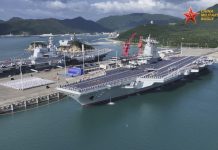Factory activity in China showed a marginal recovery last month, in a sign that stimulus infused into Asia’s growth engine may be yielding results, but concerns of a global slowdown continued due to weakness elsewhere in the region.
Even in China, growth in new domestic and export orders was marginal. Factory activity in Japan, South Korea, Malaysia, and Taiwan shrank further, adding to expectations of a dovish turn from central bankers in the region.
The U.S.-China tariff war and slowing Chinese demand after a campaign to reduce financial risk-taking have caused broad damage, hurting everyone from small firms in the supply chains of Chinese manufacturers to global tech behemoths such as Apple and across the map from Australia to South Korea and Japan.
Later on Monday, eurozone activity surveys were expected to show contraction due to its own trade frictions with the United States, Brexit uncertainty, and fallout from the U.S-China trade dispute.
The weak external environment is feeding back into the U.S. economy, prompting the Federal Reserve to abruptly end its policy tightening last month and causing the Treasury yield curve to briefly invert last week – a potential signal of a looming recession.
Fed’s pause has changed the game for many Asian central banks and investors are betting on a growing list of potential rate cutters.
“The PMI data … is telling us that the stimulus measures that have been put in place by the Chinese authorities since the middle of last year are finally starting to have an impact,” said Khoon Goh, head of Asia research at ANZ.
“Now, of course, this is just one month. I’m expecting Asian central bankers to continue to be accommodative and some of them to cut interest rates. There’s no doubt that overall growth still slowed.”
China’s Caixin/Markit Manufacturing Purchasing Managers’ Index (PMI) expanded at the strongest pace in eight months in March, rising to 50.8 from 49.9 in February, above the 50-mark dividing expansion from contraction and the highest level since July 2018.
An official survey on Sunday also showed modest expansion.
Economists also cautioned there were seasonal factors in play, with activity in March traditionally picking up markedly whenever the Chinese Lunar New Year holidays fell in February, as they did this year.
If the trend is sustained, it could mark the turnaround that China’s policymakers had hoped for after some heavy fiscal and monetary stimulus, including five cuts in bank reserve requirements in the past year, although analysts say more such measures may still be in the pipeline.
BofA Merrill Lynch analysts took note of the “green shoots” from the March PMI readings, but said real activity growth could have stayed under pressure in the first quarter, especially given the tougher environment for exports.
“We believe policymakers will stick to their commitment on policy easing to stabilize growth,” the BofA Merrill Lynch analysts said in a note to clients. Chinese Premier Li Keqiang said last month the government has additional monetary policy measures that it can take, and will even cut “its own flesh” to help finance large-scale tax cuts.
On the trade front, U.S. President Donald Trump said on Friday that talks with China were going very well, but cautioned that he would not accept anything less than a “great deal” after top U.S. and Chinese trade officials wrapped up two days of negotiations in Beijing.
“A set of better economic numbers on the Chinese side could raise the bargaining chips in negotiations with the U.S., as they could show that the Chinese economy can still bounce back from the tariffs imposed by the U.S. so far,” said Kevin Lai, chief Asia ex-Japan economist at Daiwa Capital Markets.
BROAD WEAKNESS
Activity in Vietnam, Indonesia and the Philippines grew at a modest pace, but in economies with a larger impact on regional growth the outlook remained bleak.
South Korea’s factory activity in March contracted for a fifth straight month.
Japanese manufacturing activity contracted at a slower pace in March than the previous month, but output fell at the sharpest rate in nearly three years. Japanese business confidence worsened to a two-year low in the first quarter of this year, a central bank survey showed.
Why US Applauded Indian Anti Satellite Tests While Criticising Similar Chinese Tests in 2007?
Corporate spending in Asia is likely to fall for the first time in three years, with capital expenditure at 2,137 Asian companies seen slipping an average 4 percent this year, a Reuters analysis of Refinitiv data showed.
An analysis by Oxford Economics showed nominal Asian export growth fell 3.8 percent year-on-year in January-February combined, primarily driven by a sharp fall in North Asian exports, although growth in Southeast Asia was also weak.
“So far, there are few signs that the global trade cycle has bottomed, and we see global growth still synching lower in the near term,” said Joachim Fels, global economic advisor for PIMCO, adding, however, that the Fed’s change of tack and China stimulus could lead to stabilization or even a moderate pick-up.
“These factors could enable a soft landing of sorts for the global economy – albeit with further air pockets along the flight path.”
More News at EurAsian Times
- Indian Military Base in Sabang can Strangle China at the Strait of Malacca
- Why is Japan Unhappy with Bullet Train Project in India?
- Saudi Crown Prince Unravels Deep Secrets Behind Wahhabism and Yemen War
- Al-Qaeda Recruiting Kashmiri Militants for Ghazwa-e-Hind Plan for India
- From Asia to Africa, India-Japan Defence Partnership Aggressively Countering China




